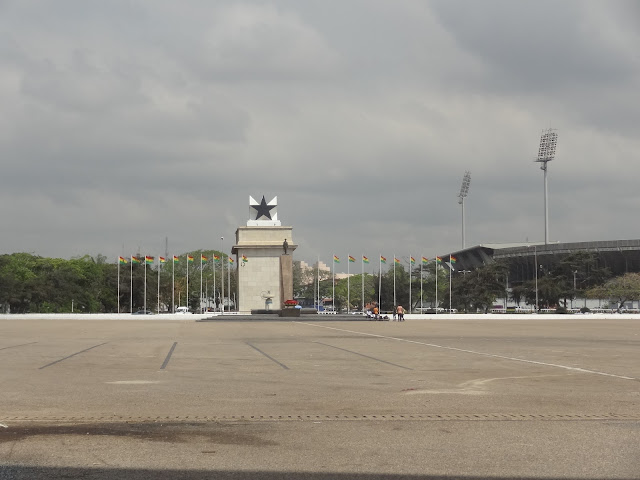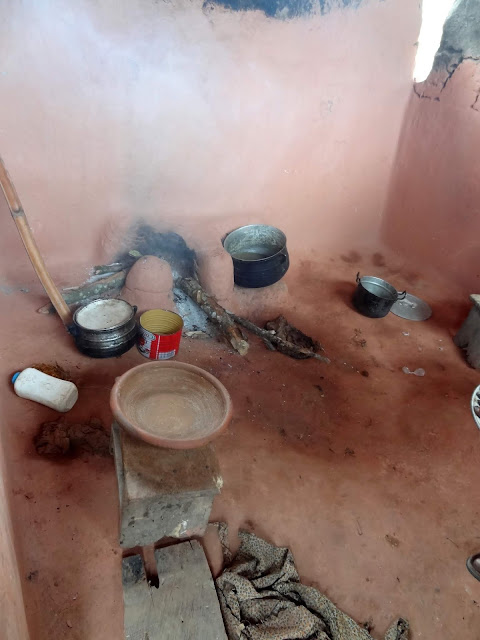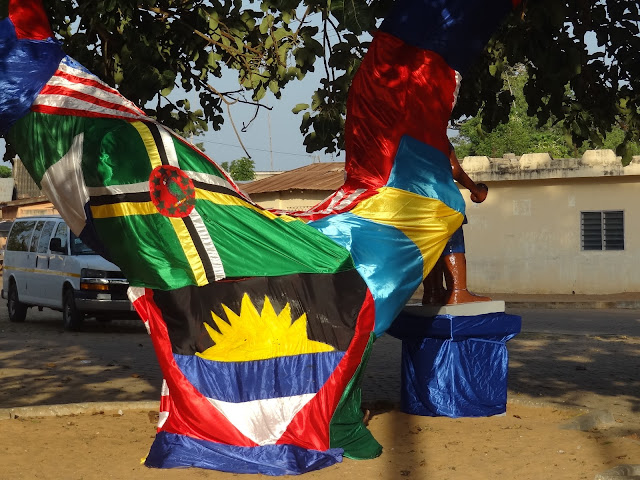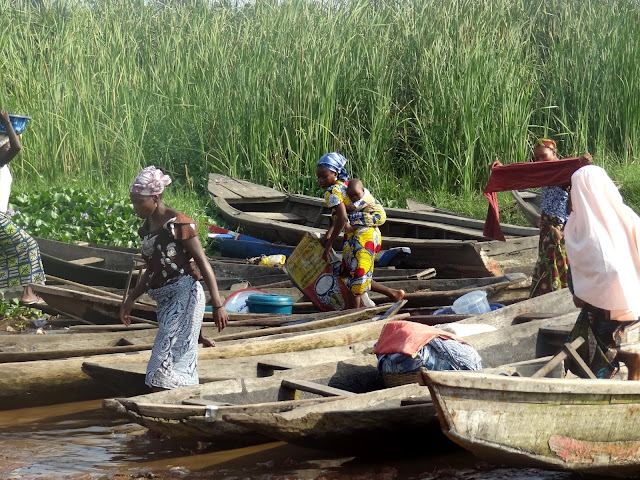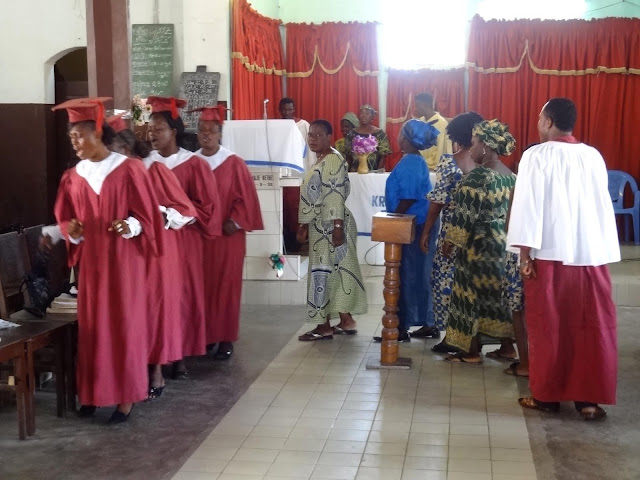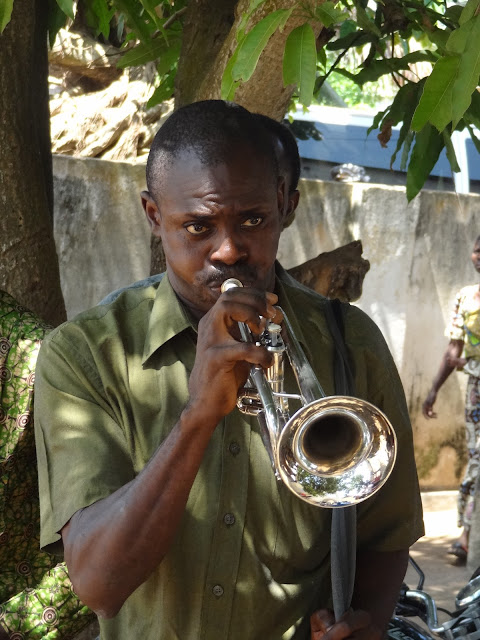What better place to see those than to visit three tiny countries aligned on the Atlantic coast of Western Africa or the Gulf of Guinea, to be more precise, Ghana, Togo and Benin.
These three countries have definitely one thing in common : heat and humidity. As you are in a sub-tropical climate, you have the impression of having entered a sauna with no door out as soon as you step out of the plane, and this until you re-board it to go home. Temperatures are stable all year around, normally at about 30 degrees Celsius, and this is hot, but it can get very hot or crazy hot. One advantage : you can drink gallons of water without worrying about finding a bathroom. All the water comes out of your pores. Bless Mr. Carrier who discovered air-conditioning.
These three countries also have in common the fact that they were the main ports for slave trade to the Americas (mainly Ghana and Benin) and that they are the birthplace of voodoo (mainly Togo and Benin).
But they also have one big difference : Ghana was a British colony, and the official language is English, whereas Togo and Benin were French colonies so the official language is French.
Religious beliefs also vary somewhat . In Ghana 70% of the people are Christian of various congregations and the other 30% is equally divided among Muslims and animists.
In Togo, 51% of the people practice voodoo (known as Santeria in Cuba and the Caribbean, Voodoo in Haiti and Candomble in Brazil), with 20% Christians and 19% Muslims.
In Benin, 60% practice voodoo with 30% Christians of mainly the Roman Catholic variety and 10% are Muslim.
So in November 2012 we took a flight from Istanbul to Accra ( I love Turkish Airlines which now flies direct to very many destinations in Africa) and reached the sauna with no door out at night. We transferred to a very nice hotel, the Villa Boutique Hotel.
It is only the next day that I saw what Accra was like. And I at once noticed that it was quite different from the two other West African capital cities I had seen, namely Bamoko (Mali) and Ougadougou (Burkina Faso). The fact that Ghana is much richer than Mali or Burkina Faso is immediately noticeable. The streets are in much better condition, the sewers are covered more than they are open, there is a lot less litter and everything feels much more civilized. You can see Accra is a fast developing city with high-rise buildings going up everywhere as flats, hotels, offices and shopping malls.
The economic wealth of Ghana is due to the fact that it is the most politically stable country in West Africa. It is also one of the few African countries that managed to create a nation rather than a collection of tribes.
Did I like Accra ? Not much. I want to see Africa, not a semi- European city with lots of colored people in it.
Our first stop, Independence Square , shows why I did not particularly like modern Accra. The square is a huge open-air parade ground by the sea like post-colonial rulers seem to like. A massive concrete arch dominates the parade ground while Independence Arch stands alongside in the middle of a nearby roundabout celebrating Ghana's independence in 1957. And to make matters worse, you have also a stadium adjacent to the concrete square.
 |
| THE GHANAİAN FLAG |
 |
| THE COAT OF ARMS OF THE PRESİDENT. |
 |
| PRESIDENTIAL LODGE |
 |
| WHY A STADİUM HERE ? |
The good thing is that you see Africa too in Accra as you go out of the posh suburbs and head towards James Town, the run-down area of the city. Here the streets are packed with people playing drums, listening to music, shopping in markets.
North of James Town lies the main market in town, Makola Market. Here everything spills on the streets - hawkers, pedestrians, stalls - and it is a colorful chaos where you can buy practically anything. Some may find the crowds, the noise level and overall activity intimidating but I loved it.
 |
| JAMES TOWN |
 |
| MAKOLA MARKET |
 |
| I HATE THAT - PİG FEET. |
 |
| FİSH |
 |
| MANİCURE-PEDİCURE İN THE MİDDLE OF THE MARKET - THAT WAS THE BEST. |
 |
| THEY ARE MAKİNG MUSİC WHENEVER THEY CAN. |
Our last market of the day was a handicraft market where touristic paraphernalia is actually being made (and sold of course).

 |
| A PARADİSE FOR MASK COLLECTORS |
 |
| RAW MASKS - THEY STİLL HAVE TO BE WORKED ON. BUT İT LOOKS LİKE MASS PRODUCTİON DOESN'T İT |
 |
| THE HEAD CUSHİON OF ROYALTY - MUST BE EXTREMELY UNCOMFORTABLE. |
The next day we left Accra towards Kumasi and on the way we visited a bead factory. I have to admit it is the first time I saw how glass beads are made.
Glass beads, mostly made in Venice, were introduced to Africa by European traders as a highly valued item in exchange for raw materials, ivory, salt and slaves. As glass making was almost non-existent in Africa at the time , the beads were much valued as a status symbol to be worn by chiefs and higher ranking officials.
Today, glass beads are made in Ghana from glass detritus. And I found them very original with beautiful colors. I bought several colors, had them made into necklaces and ear rings mixing with leather and silver and still wear them with great pleasure today.
 |
| THİS GENTLEMAN İS THE BEAD ARTİST. |
 |
| HE MAKES BEAUTİFUL DESİGNS İNTO GLASSES BY USİNG SEVERAL COLORS OF GLASS. |
 |
| TO MAKE THE BEADS, GLASS DETRİTUS İS PUT İNTO ROUND SHAPE MOULDS. |
 |
| AND THEN PUSHED İNTO AN OVEN. |
 |
| THE BEADS ARE READY TO BE PAİNTED. |
 |
| AFTER PAİNTİNG, THEY ARE PUT İNTO A SPECİAL SOLUTİON TO HELP KEEP THE COLORS SAFE. |
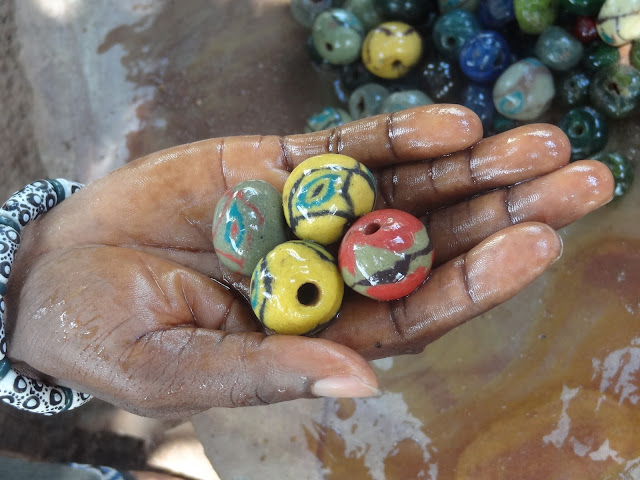 |
| AND HERE ARE YOUR BEADS. |
Little is known of the small African kingdoms of the region until the arrival of Europeans in the 15th century. It was first Portuguese navigators, working their way down the West African coast, who reached this area and built a fortress in Elmina in 1482. But others followed fast. As early as 1492 a French buccaneer stole the cargo of a Portuguese ship. That cargo was gold; and the Gold Coast became the European name for this part of Africa.
The trade in gold with the Europeans made possible the development, in the early 17th century, of Akwamu, the first African kingdom to control an extensive part of the coast. During the 18th century, the dominance of Akwamu was replaced by that of a much more powerful group, the Ashanti, with their capital at Kumasi.
The Ashanti people were very powerful militarily, with an army close to 200.000 people at its peak. They used firearms earlier then any other group nearby and used effective fighting strategies which would explain four British defeats before being able for the British to conquer the Ashanti.
The Kingdom also had a very sophisticated government, with the central government controlling almost everything and people paying taxes to it. The empire then covered present central Ghana , Togo and the Ivory Coast.
By this time, the British, Dutch and Danes were the main European traders on this part of the coast, and the most valuable commodity for export was not gold anymore, but slaves, enabling the Ashanti to acquire great local power.
The Dutch and the Danes abandoned the coast in the 1870 and in 1874 Ghana was formally proclaimed a British colony, under the name Gold Coast. The colonial years were relatively prosperous and untroubled, but in the years immediately after World War II, events moved very fast and the turning point was the return of Kwame Nkrumah after 12 years of study and radical politics in the USA and Britain. As such, in 1957, the Gold Coast became the first colony in sub-Saharan Africa to win its independence under the name Ghana.
Do not thing the Ashanti Kingdom died in 1874. It was disbanded of course, but it never completely ceased to exist in the central region of Ghana and the line of Ashanti kings keeps going in a ceremonial sense. The Ashanti tribe is still the largest in Ghana today.
On the way to Kumasi we stop at a village called Ejisu to visit the Ejisu Besease, an ancestral shrine of the Ashanti built around 1850 and reflecting the traditional Ashanti architecture.
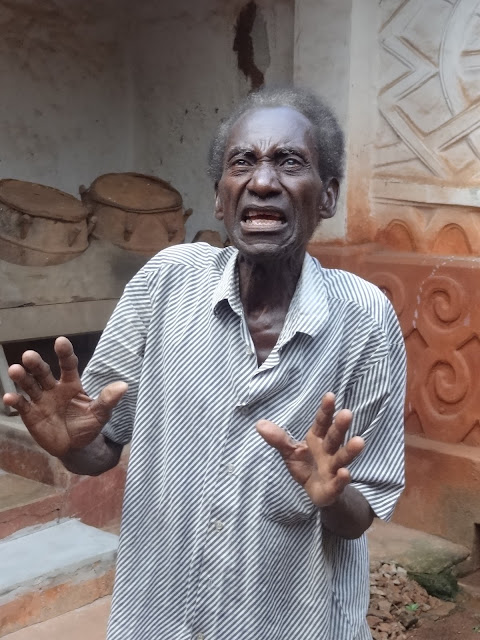 |
| THE ASHANTİ PRİEST TELLİNG US THE STORY OF THE ASHANTİS |
 |
| OUR GUİDE TRANSLATİNG. |
 |
| DETAİLS |
After a good night's sleep we leave the next morning to visit Bonwire, a village near Kumasi, where the famous Ashanti Kente cloth is hand-made on looms in a tradition passed down through generations. ''Kente '' means basket or woven cloth. In the past, Kente cloth was the traditional fabric made of silk worn by the Ashanti kings and nobility but today it can be bought in its cotton form in almost all West African markets.
We first visited the loom and then the village itself.
 |
| HE WEARS KENTE CLOTH |
Ashanti culture centers on ancestral worship so every 42 days (according to the Ashanti calendar this makes once a month) it is customary to come in contact with the ancestors and give them thanks for their protection since it is believed that the ancestors are the custodians of the Ashanti laws and customs. At the same time, the Akwasidae festival commemorates the date that the Ashanti Golden Stool was magically brought down from heaven. This stool is what gives its authority to the King , otherwise known as Asantehene, as believed by the Ashanti people.
The central figure of attention here is the King who comes carried on a palanquin and then seated in a central place while a procession of Ashanti people pay homage to him (hierarchically). After the King come the great chiefs, divisional chiefs, local village chiefs and finally the clan or family head.
The public ceremonies take the form of a colorful reunion of chiefs and queen mothers presided over by the Asantehene. It also provides a platform for the king to meet and share his thoughts with his sub-chiefs and subjects and also reward deserving ones.
The celebrations parades colorful canopies and umbrellas, lots of kente design since everyone wears it, drummers, dancers, horn blowers and singers who perform in honor of their ancestral spirits. For tourists like us it is quite a spectacle.
 |
| THE FESTİVAL GROUNDS |
 |
| İT İS A BİT EARLY SO WOMEN ARE WAİTİNG İN THE SHADOW. |
 |
| MEN ARE ARRİVİNG BUT THİS NOT THE NOBİLİTY, ONLY THE PEOPLE. |
 |
| EVERYBODY İS SEATED AND WAİTİNG FOR THE KİNG AND THE NOBİLİTY TO ARRİVE. |
 |
| THOSE SLİPPERS REALLY LOOK NİCE ON THOSE HUGE BLACK MEN !!!!!!! |
 |
| TOURİSTS ARE WAİTİNG AS WELL. |
Ashanti noblemen arrive in procession, draped in their Kente cloth.
Then the women's procession arrives and everyone settles down.
In the meantime, the King has arrived too ; it is the guy in the middle with the starry bonnet, surrounded by the bigger chiefs.
And the music and dancing starts.
Of course there were children around. Here are some of them.
 |
| THE HAİR MODEL İS BEAUTİFUL. |
 |
| HOW ABOUT THAT ONE ? |
After a second night in Kumasi, we continue towards the Central Region to reach Elmina. On the way we stop at Mesomagor village to listen to the Bamboo Orchestra. The youth of this village have revived a traditional art and perform with bamboo percussion instruments to songs and dance.
We first go around the village itself which is very poor. But nevertheless the people seem happy.
The houses are miserable inside as well.
And the church has a priest but not much else. Luckily enough, it seems there is a school in the village.
But the inhabitants definitely have a sense of humor and are problem solvers.
 |
| BRAVO - İT SEEMS THİS VİLLAGE DOES NOT EVEN HAVE ELECTRİCİTY. |
 |
| A CLEVER WAY TO CHARGE MOBİLE PHONES İF YOU HAVE NO ELECTRİCİTY. AND SEVERAL OF THOSE CHARGES WERE PLACED AROUND THE VİLLAGE FOR THE PEOPLE TO USE. |
Where there is music, there is singing and dancing. Even small children dance here.
 |
| I DO NOT EXACTLY KNOW BUT I HAD THE İMPRESSİON THİS DANCE WAS VERY MUCH RELATED TO SLAVE TRADE . |
The first castle we visited was the smaller of the two, Elmina Castle or St George's Castle of its real name. It is a UNESCO World Heritage site. The history of those two castles makes pretty ugly reading.
The story starts back in 1482 when the first Portuguese explorer, Captain Diego d'Azambuja, sought permission from the local king to build a fort in his territory, at Elmina. Construction started the same year and St George's Castle is the oldest major stone structure to be erected by Europeans in the Tropics since this was 10 years before Christopher Columbus made his trip to the Americas. The Portuguese also built a Franciscan church on the hill behind the castle dedicated to St George, having thus built the first Christian church in Ghana and the first known Christian church in Africa outside Ethiopia. A walled town developed around the castle and by the early 1600's it was a self-governing city state.
By the 1600's, the Dutch had set up a commercial center 20 km away and were intent on expanding. After several Dutch attacks, the Portuguese surrendered the castle to the Dutch in 1637.
The Dutch converted the existing church into a large trading hall and built their own Protestant church within the walls. They remained in possession of the castle until 1872 when they sold it to the British to concentrate on their more lucrative interests in Indonesia.
As slavery had been abolished by then, the castle became a colonial police academy and it remained an academy after Ghana's independence until it was declared a national monument in 1972.
The castle is lovely, with shaded courtyards, ramparts strutted with turreted towers and the view from there is beautiful.
So far so good. We have all read books about slaves, we have all seen films on the subject and we all know Kunta Kinte. But nothing prepares you for that feeling of a hand squeezing your throat when you see the places where it really did happen. And the two castles at Elmina, among others, were where it did happen. They were the biggest trading posts in that most abhorrent of all cargoes, slaves. The slaves were being sent to the New World, and gathered from all of West Africa, plus countries like the actual Niger, Nigeria or the Congo, Uganda and Angola.
African slaves were captured in a number of ways but the most common was for the Europeans to encourage inter-tribal wars. These would produce prisoners of war on both sides, who would then be sold to Europeans in exchange for guns which would then be used to capture even more neighboring tribesmen.
St George Castle and Cape Coast Castle saw human degradation reach its lowest point. The dungeons in St George Castle aren't as large as those under Cape Coast Castle, and whereas the former could only hold about 100 men and 100 women, the latter could hold 1000 men and 500 women.
What I knew, but only vaguely before, is that slave trade was operating in this area well before Europeans started building forts along the West African Coast. Indeed, slaves had been bought and sold along the trans-Saharan trade route since pre-Roman times (that surprised me the most). With the expansion of Islam in the 8th century, things really started taking off ; each year from around 800 to the 1600's , between 5.000 and 10.000 slaves were bought and sold on the African continent.
As we have seen above, the smell of gold brought the Europeans into contact with West Africa. Even though they made huge amounts of money by trading gold, they realized that profits could be enhanced by trading humans so they moved into the already thriving slave trade, thus getting a taste of the profits that could be made, a taste that would not turn sour until the 19th century.
With increased European presence in West Africa, the slave trade started to escalate. It was not before long that a triangular system was in place : ships were leaving Europe for West Africa charged with textiles, metals, guns, rum, tobacco, ceramics and beads. In West Africa, these goods would be traded for gold, ivory, pepper and slaves before heading for the New World, where slaves would be sold to work on plantations, in exchange for sugar, cotton and tobacco. Each ship would take between 18 months and three years to complete the journey but it was a profitable investment so the European powers started building their empires on slave labor. It is a sad and tragic story and to think that the wealth of certain nations was accrued immensely by this ruthless system upset me even more.
The statistics on the slave trade are mind boggling : between 1525 and 1856, 12 million Africans were captured and forcefully taken from their homelands. Not all of those reached the New World though since many died on the trek from the interior to the port and many more on their passage to the Americas. Today, the descendants of those slaves constitute the African Diaspora in the New World since originally one third ended up in Brazil, one third in the Caribbean Islands and the rest throughout the Americas.
The castles on the coast of West Africa are chilling reminders of the cruelty of the human spirit.
Slaves would first be brought to the forts. There, they would be put into dark, damp dungeons with no ventilation and no sanitation, surviving on minimal food and water. For six to twelve weeks, those people would literally live shoulder-to-shoulder in their own faeces and thousands died before they could even see a ship. When you visit those dungeons, you literally walk on several inches of old, solidified excrement . And the skull and crossbones at the entrance of the dungeons sums it all.
The women's dungeons in St George Castle are not underground as those in Cape Coast Castle,but open into one of the castle's tallest courtyards. At the top of this courtyard is a balcony that formed part of the officers' quarters. That is where the officers would stand and order the female salves to be hauled out and paraded in the courtyard below. And if they liked the look of any, they would have them sent upstairs where they would rape them.
 |
| THE İNFAMOUS COURTYARD. |
When a slave ship arrived, those unfortunate men, women and children would be led down a dark corridor to the ''Door of No Return'', a one-person-wide slot through which they would walk, chained and manacled, looking for the last time at their homeland.
Conditions on the ships were even worse, with the slaves being packed literally as sardines in a can. Between a quarter and half of the slaves would die before reaching their destination.
The irony is that the pastor and his flock must have been praying for salvation in the church above, while unimaginable cruelty was happening just below them.
Everything is well-summarized in an epitaph in the courtyard of St George's Castle .
After such a visit you feel as if you need to breath again to make you overcome the horror you have seen and vividly imagined . So we went on to visit the Elmina fishing port, such a lively place, with fishing boats coming back from the sea, fish being discharged, nets being cleaned and re-arranged and a joyous crowd of fishermen.
 |
| OUR HOTEL- COCONUT GROVE BEACH RESORT. |
 |
| THE BEACH İN FRONT OF OUR HOTEL |
 |
| AND HERE İS THE SUNSET |
The next morning we leave Ghana for Togo, more specifically Lome, its capital city. But before passing the border controls, we have a last stop in Ghana at a very funny place. This is a workshop where coffins are made on demand and usually they are ordered by family members according to the profession or the likes of the deceased. I have never seen such funny coffins in my life.
 |
| THE DECEASED MUST HAVE BEEN A TAİLOR |
 |
| THİS GUY MUST HAVE LOVED CARS |
 |
| I REALLY COULD NOT FİGURE OUT WHY SOMEONE CHOSE TO BE BURİED İN A SOFT DRİNK CAN. |
 |
| WAS HE ALWAYS DREAMİNG OF GOİNG TO VENİCE OR WAS HE A FİSHERMAN ? |
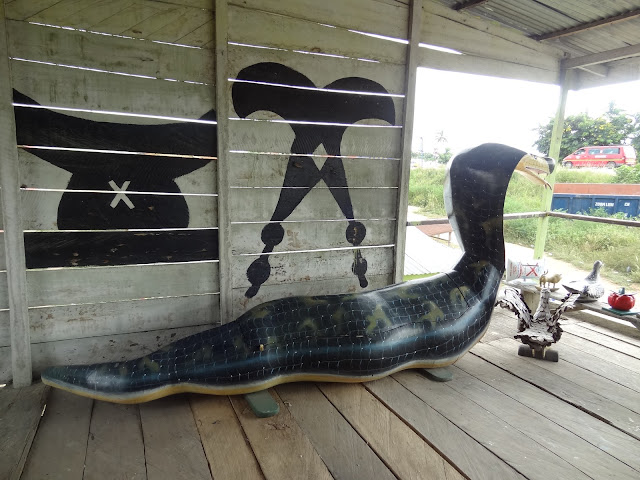 |
| WHO COULD EVEN BE CONSİDERED BEİNG BURİED İN A SNAKE ????? |
And here we are in Togo. Togo is a tiny country squeezed between Ghana and Benin. It has a 50 km coastline on the Atlantic Ocean and it is only 600 km inwards.
It was a German colony before World war I and was called Togoland . After the Germans lost the war, the country was divided, some going to the British (Ghana) and some to this new country, Togo, which was to be run by the French - again a pencil line drawn by colonial powers with no respect at all for the wishes of the local people who were considered too inferior to be able to make a ''wise'' decision on ''such a complex issue ''.
Once you arrive in Lome, it is easy to see the difference with Ghana ; the buildings are run down, the cars are in worse shape and there is a sense of neglect in the air. We just stopped at the main square .

 |
| THE MONUMENT TO INDEPENDENCE |
 |
| THE TALLEST BUİLDİNG İN LOME İS A HOTEL |
There are beautiful beaches in Lome, with lots of palm trees. Unfortunately, it seems those beaches are not good for swimming due to strong currents and the fact that they are used as public toilet.
Togo is kind of low on sights to see but this is compensated by its most unique attraction , the Akodessawa Fetish Market or Marche des Feticheurs, the biggest fetish market in the world.
Fetish means voodoo so let me try to explain what voodoo is.
Thanks to Hollywood, I believe most of you and definitely me, always associated voodoo with witchcraft, black magic, and sticking pins into dolls to harm or kill someone. Well not at all. Voodoo is in fact a religion, an animist belief system with a creator god and the attribution of a soul to natural objects and phenomena. It restores the harmony between mankind and the universe through mineral, herbal, animal and spiritual rituals.
There are over 40 different gods, or fetishes, in the voodoo religion, and each god selects his ''feticheur'' or fetish priest with whom he will communicate through dreams, broken shells or other means. Those conversations take place in the priest's hut where there are small statues that act as channel for communication. The ability to communicate with the gods often runs in the family, meaning you do not become a fetish priest but you are born one.
The basic philosophy of the religion is that everything in the universe is connected. Nothing happens by accident in this world. Voodoo belief recognizes one Supreme Being who created the universe, but who is too far away for a personal relationship with his worshippers. Below this almighty god, spirits or Loa, rule over worldly affairs of family, happiness, luck, justice, health, wealth, work, the harvest or the hunt and what not. These Loas are the spirits of ancestors, animals, natural forces, and the spirits of good and evil. Worshippers serve the Loa to gain guidance for their lives.
Voodoo ceremonies contain prayers, dancing and rituals. They also include animal sacrifices (mostly chicken). These are a way to connect with the spirits .
The central and key aspect of Voodoo is healing people from illness, not doing harm to them.
Even though vodoo is also practiced in Togo, the birth place of this belief system is Ouidah in Benin so why is the biggest fetish market of the world in Lome-Togo ? Very simple : good business acumen.
The market was first established 152 years ago by Beninese founders who were not only healers but shrewed businessmen who realized that the market for fetish objects and traditional pharmacies was over saturated in Benin. But in Togo, where the voodoo religion was important, there were far fewer such markets. In order to bring more revenue, the Marche des Feticheurs was moved from Benin to Togo in the latest years of the 19th century.
In this pharmacy that is Akodessawa Market, there is a treatment to any ailment you might have. From buffalo skull to antelope horn, from desiccated cobra to bear skin, from monkeys to alligators, passing by goats or gazelles , all in various stages of decay and stacked up on wooden tables or on the ground, the fetish priests have everything at their fingertips ready to be ground, burned, imbibed, or whatever else the gods may desire. As such, couples who cannot have babies, goalkeepers who want to do wonders in a football match, students who want to succeed in their exams, people who want stamina to finish a certain job, women who want to protect their children from the evil eye , those who have the flu or want to remove the blackest of curses , all come here to get a talisman or a powder or a paste infused with the blessings of the divine, to have their wishes come true and to solve their problems. As a result, fetish priests from all over Africa flock here to get the necessary ''medicines'' for their ''patients''.
One important note here ; according to voodoo belief, the animals sold on the market cannot be killed for the purpose of sale. The fetish priest first consults the spirits to be sure that the animal was found dead rather than killed and only then does he use it in his cures.
A second question to answer is why is voodoo so important in Haiti even though it was born in Benin. Simple answer: it seems almost all the slaves that were brought to Haiti were from Ouidah in Benin, the birthplace of voodoo ( a town we will visit shortly). So they took their beliefs with them.
 |
| GENERAL VİEW OF THE MARKET. THERE İS A PERMEATİNG ODOR OF DECOMPOSITION AROUND HERE. |
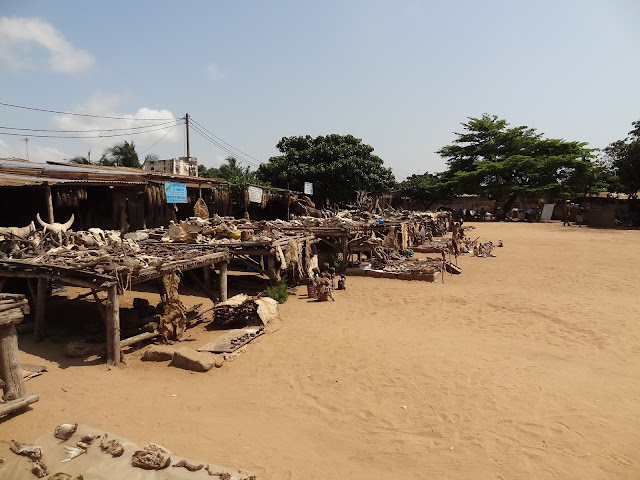 |
| THE STALLS ARE SET UP ON EİTHER SİDE OF A SQUARE LİKE ANY SUBURBAN FARMERS' MARKET. |
 |
| A GRUESOME GALLERY OF LİFELESS FACES STARİNG AT YOU. |
 |
| THİS İS THE ONLY VOODOO MARKET WHERE FETİSH PRİESTS HAVE SMALL CABİNS AND CAN OFFER YOU CURES FOR YOUR AİLMENTS. |
 |
| THE VOODOO DOLLS |
After this strange experience, we continue on to the main market of Lome where we will first have a look at the cathedral since it sits right in the middle of the very busy Central Market.
The Cathedrale du Sacre Coeur, or German Cathedral as is generally known, is the biggest church in Togo and was built by the Germans, in a Gothic style, in 1905.
Our next stop is at a little red-earth village to watch a (touristic of course) voodoo ceremony.
According to me, the village is interesting and the people and children are even more interesting than the ceremony itself.
The children around are really cute.
 |
| İT İS A PİTY NOBODY DİSCOVERED HER SİNCE SHE WOULD MAKE A GREAT MODEL. |
We then go to watch the voodoo ceremony. First the people gather , than a priest arrives and sits down in front of his ''wares'', and music and dancing start and go on and on and on until finally a chicken is sacrificed. I cannot say I was very excited since it really did seem a bit too touristic to me, and not at all mystical.
 |
| THE VOODOO PRİEST |
 |
| MUSİC İS STARTİNG |
 |
| SİNGİNG.... |
 |
| AND DANCİNG. |
After having spent the night in Lome, we cross the border into Benin, and drive up to Ouidah.
Togo's twin on the great bulge of the West African coast is Benin which was called Dahomey until 1960 when the country achieved independence form colonial rule. The country was the site of Dahomey, a prominent West African kingdom that rose in the 15th century. The territory became a French colony in 1872 and that till independence.
French is the official language of the country which is understandable since in a population of a bit more than ten million, it seems around 50 different dialects are spoken.
Benin is the only country in the world , with Haiti, which recognizes voodoo as a state religion (surprising, no ?). Voodoo is such an integral part of the culture that even Christians and Muslims in this country respect some of its superstitions and traditions.
The small town of Ouidah, on the Atlantic coast, is important from two aspects : it is the birth place of voodoo and it is an important port for the slave trade to the Americas since it was from here that most of Benin's slaves were ''exported'' to the New World.
We started our visit with the Sacred Forest, the Mecca of voodoo, and a highly spiritual place for voodoo believers.
The forest is the resting place of King Kpasse, the first king of Ouidah. When he felt he was near death, the king disappeared since he did not want anyone to see his body and his children later discovered that he had turned into a small Iroko tree growing in the grass in the forest. According to the wish the king made before he died, each year a ceremony is held in the forest in his memory and this still goes on today.
In this forest, called locally Kpassezounmin, there are many statues of traditional voodoo deities , several sacrificial sites where periodic goat and chicken sacrifices are made to placate the voodoo spirits, and small voodoo temples.
 |
| THE ENTRANCE FEATURES AN İROKO TREE FLANKED BY TWO LEOPARDS, SYMBOL OF THE OUİDAH KİNGS |
 |
| A VOODOO DEİTY |
Legba - the guardian spirit of towns, villages and homes, sits on a traditional stool with his hands on his knees. As a symbol of fertility he has a penis nearly as long as his horns.
 |
| SAKPATASSİ - GOD OF SMALLPOX |
 |
| HEVİOSSO - THE GOD OF THUNDER |
 |
| FEMALE VERSİON OF THE GOD OF THUNDER. |
 |
| AİDOHWEDO - THE RAİNBOW GOD AND ALSO THE GOD OF CONTİNUİTY AND WEALTH |
 |
| THİS DEİTY MADE OF SCRAP METAL İS SAİD TO BE THE GOD OF MACHİNERY |
 |
| A VOODOO DOLL- A TİN PANEL-MAN WİTH PİNS ALL OVER HİM - TO PUNİSH DİSOBEDİENCE |
 |
| KİNG KPASSE İS BELİEVED TO BE İN THİS SHED |
 |
| AGAİN THE SYMBOL OF THE OUİDAH KİNGS |
 |
| SMALL VOODOO TEMPLES ALL PERFECTLY DECORATED |
 |
| İT SEEMS LOTS OF PALM TREES HAVE BEEN PLANTED. |
 |
| FİSHERMEN PULLİNG THEİR NETS. |
According to voodoo belief, the snake is a deity called Dangbe and represents infinity, so it has been revered for centuries. The deity's ancestors are protected and honored here in the temple.
To prove how voodoo and other religions peacefully co-exist together, just across the temple lies the Catholic Ouidah Basilica, which according to the photos inside and out has even been visited by the Pope.
And now to the ''Route des Esclaves'' or the Slave Route, a route that follows the slaves' journey from being sold in the market to boarding the slave ships and leaving Africa.
The slave trade in Benin operated exactly the same way as the one in Ghana with the only difference that here it was the Dahomey kings who caught their brothers to be sold to the Europeans.
It all starts at the Chacha Place where the slave auctions were held under the huge tree in the middle of the square. The pictures on the walls of the adjacent buildings portray slavery.
Nearby is the Zomai Cabin , an obscure hut with no light whatsoever to disorient the slaves who were auctioned and held here prior to departure. The claustrophobic quarters in the cabin was also for the slaves to be used to the conditions they would face on board the ships. The hut does not exist anymore but there are statues in the garden commemorating this horrible fact.
 |
| NO PLACE TO MOVE AND NO WAY TO SPEAK. |
Then comes the Tree of Forgetting. Here the slaves were branded with hot irons according to the mark of their respective buyers. The name of the place , however, stems from the ritual of turning the slaves around the tree ( 9 times for men and 7 times for women) to reinforce their forgetfulness of their homes. The slaves would not forget of course, but for them this turning around the tree would ensure that their spirits would return to their homeland after death.
Walking towards the beach, we come to the Wall of Lamentations also called Memorial of Remembrance. It is 6 meters tall and the imagery displayed on it tells the story of slavery in Benin. The wall was erected on the site of a mass grave of slaves who died before leaving for the New World.
 |
| THE STATUES ARE PRETTY NAİVE BUT TELL A LOT |
You then reach the beach, the end of the route. Here the slaves were loaded on longboats and taken to the slave-trading vessels waiting at large. On the beach today stands a monument erected by UNESCO in memory of all the slaves that were boarded on ship from this point, more than a million people between the 17th and 19th centuries. This monument is aptly called ''The Point of no Return''.
After this rather gruesome walk, we leave Ouidah for Cotonou where we will spend the night.
Located along the coast, Cotonou is the largest city in Benin, but it is not the political capital. The capital city of Benin is Porto Novo. Cotonou is the economic capital only. Cotonou seems to be a hectic, loud, polluted and chaotic city with nothing much to see. In fact we did not come here for Cotonou per se, but to visit the ''Venice of Africa'', the floating village of Ganvie, where 20.000 people actually live.
Ganvie is on Lake Nokoue and can only be reached by boat. İts history is quite interesting . The town was founded in the 1700's as a refuge for people of the Fon ethnic group trying to avoid being captured by the dominant, warring ethnic group, the Dahomey, who sold captives into the slave trade. So the Fon built an entire village on stilts, two meters over the water, allowing them to escape the aggression of the Dahomey, since the latter's religious beliefs prevented their warriors from venturing onto water, be it the sea, a lake or even a stream.
On the shore of the lake where we boarded our boat to reach Ganvie, people were unloading fish and an array of other aquatic life from their dugout canoes en route to the market in town.
On the lake, we witnessed different types of canoes going by.
We arrived to the village with hundreds of bamboo and corrugated iron huts jutting from the murky water, and a traffic of townspeople in canoes maneuvering through its myriad canals and waterways. Here everything is really on water, except for the two ''most important'' buildings, the church and the mosque.
 |
| NEAR THE VİLLAGE, THE WATER HYACİNTH MAKE A BEAUTİFUL SİGHT. |
 |
| SHOULD HE REALLY BE SWİMMİNG HERE ? IT SEEMS THE SEWAGE OF 20.000 PEOPLE ARE İN THİS WATER. |
 |
| YOU LEARN YOUR WAY ON WATER AT A VERY YOUNG AGE. |
Another day is over and tomorrow we will go back to Accra to take our plane back home. So here we are crossing Togo again and entering Ghana when we hear very lively music in a village. We have to stop. The music comes from a ceremony at a church.
 |
| MUSİC İS ON |
 |
| THE CHOİR İS SİNGİNG |
 |
| AND THAT İS THE FUNNY PART - A BİG BAG OF ONİONS İS AUCTİONED. |
 |
| AFTER THE CEREMONY, PEOPLE LEAVE THE CHURCH |
 |
| BUT SİNGİNG GOES ON. |
And thus another interesting journey is over. It was a very informative one for me.
I have learned a lot about voodoo which, I discovered, is a religion of peace and healing.
I have also learned more about the slave trade and that for the sake of wealth no principles ruled anybody's conduct. I have realized even more that those who , with great hypocrisy, proclaim themselves agents of civilization committed one of the worst crimes against humanity and thus altered the face of the earth.
But most interesting to me was a conversation I had with our local guide. I asked our guide : '' After you tell me what happened here and after seeing all those places with my own eyes, I feel real bad. So you must feel worse. Do you hate the white man for what they did to your brothers ?'' The answer was very interesting : '' Sometimes, when I explain what happened I feel anger. But when I think about it, I must admit the blame must be shared between the white and the black man. The white man sat on the coast. It is us, the black man, who caught our own brothers and sold them to the white man in exchange for money or goods. Some kings literally sold their tribes to become rich. We are not blameless ''.
It is very difficult for countries and their people to come to term with the ''bad'' parts of their history. The people of Ghana, Togo and Benin, who were for a long time considered ''less than human beings'', have managed to come to term with their past and clearly admit their mistakes. It takes a lot of courage to do this.

